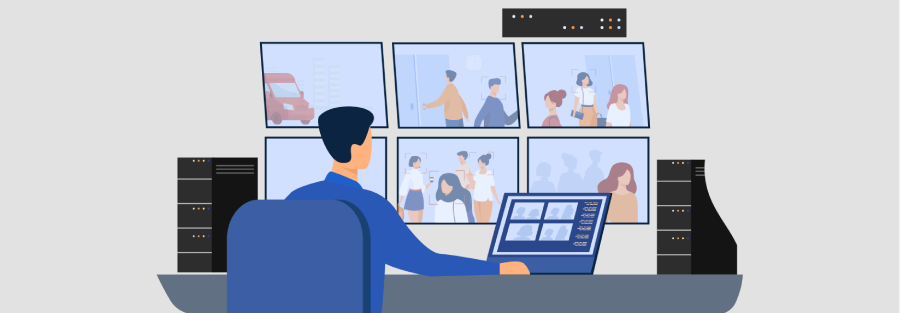The Transformative Impact of AI on Video Surveillance and Security Systems
Introduction: Video surveillance and security systems play a crucial role in safeguarding people, assets, and public spaces. In recent years, the integration of artificial intelligence (AI) has brought about a revolutionary transformation in these systems. By harnessing the power of AI, video surveillance has become more intelligent, efficient, and proactive in detecting and responding to security threats.
AI-Powered Video Analytics: At the heart of this transformation is AI-powered video analytics, which enables the automatic analysis and interpretation of video footage in real-time. This technology offers numerous advantages for video surveillance systems. Firstly, AI algorithms can accurately detect and identify threats, such as unauthorised access, suspicious behaviours, or abandoned objects, reducing the reliance on human monitoring and increasing overall security.
Enhanced object recognition and tracking are another key benefit of AI in video surveillance systems. AI algorithms can distinguish between different objects and track their movements across multiple camera feeds. This capability enables effective monitoring of crowded areas, tracking of individuals of interest, and identification of unusual or prohibited activities.
Automated alerts and notifications are integral to AI-powered video analytics. The system can be configured to send immediate notifications to security personnel or relevant authorities when predefined security events occur. This swift response allows for timely intervention and helps prevent security incidents from escalating.
Moreover, AI enables behavioural analysis and anomaly detection. By learning patterns and normal behaviours within a monitored environment, AI algorithms can identify deviations and flag potential threats. This proactive approach enhances situational awareness and enables security teams to take preventive measures before an incident occurs.
Facial Recognition Technology: AI-driven facial recognition technology has revolutionised video surveillance monitoring by providing advanced identification and authentication capabilities. Facial recognition algorithms can accurately match faces against databases of known individuals, instantly identifying persons of interest or potential threats.
In terms of access control and monitoring, facial recognition enables secure and efficient verification processes. It replaces traditional methods like key cards or PIN codes with biometric identification, reducing the risk of unauthorised access and enhancing overall security.
Facial recognition also facilitates rapid response to security threats. When integrated with video surveillance systems, it can instantly recognize known individuals with a history of criminal activity or persons on watchlists. This immediate identification enables security personnel to take appropriate action promptly.
Predictive Analytics and Risk Assessment: AI’s predictive analytics capabilities have transformed security systems by enabling proactive threat mitigation. By analysing historical data, AI algorithms can identify patterns and trends, allowing for the prediction of potential security incidents. This foresight helps security teams allocate resources effectively and implement preventive measures to mitigate risks.
Predictive analytics also aids in identifying vulnerabilities in security systems. AI algorithms can analyse data from various sources, including video feeds, access logs, and sensor data, to detect weak points or potential security breaches. By addressing these vulnerabilities proactively, organisations can strengthen their security posture and minimise the likelihood of successful attacks.
Smart Surveillance and Automated Response: AI-enabled smart security surveillance systems have ushered in a new era of proactive security. These systems utilise advanced algorithms to monitor and analyse video feeds intelligently. They can automatically detect specific behaviours or events, such as intrusions, loitering, or object tampering, and trigger appropriate responses.
Automated incident detection and response are key advantages of smart surveillance. When suspicious activities or events are detected, the system can automatically send alerts, activate alarms, or notify security personnel. This immediate response minimises response times, increasing the chances of preventing or minimising the impact of security incidents.
Integration with other security technologies, such as access control systems or perimeter sensors, further enhances the effectiveness of smart surveillance. AI algorithms can integrate data from various sources, providing a comprehensive view of the security landscape. This holistic approach improves threat detection and response capabilities.
Additionally, AI-enabled surveillance systems reduce human error and operational costs. By automating labour-intensive tasks, such as monitoring multiple camera feeds or reviewing hours of video footage, AI alleviates the burden on security personnel, allowing them to focus on critical decision-making and response activities. This efficiency translates into cost savings and ensures a higher level of security coverage.
Future Trends and Implications: Looking ahead, advancements in machine learning and computer vision will further enhance the capabilities of AI in video surveillance. Integration with Internet of Things (IoT) and cloud technologies will enable more intelligent and connected security systems. However, ethical and legal implications, such as facial recognition regulation and data protection, will need to be carefully navigated to ensure the responsible use of AI in security.
Conclusion: The integration of AI into video monitoring system and surveillance has revolutionised the way we approach security. AI-powered video analytics, facial recognition technology, predictive analytics, and smart surveillance have all contributed to more efficient and effective security solutions. By embracing the potential of AI while addressing ethical considerations and privacy concerns, we can create safer and more secure environments for individuals, organisations, and communities.



